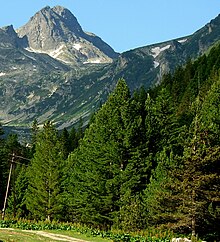Pinus peuce
| Pinus peuce | |
|---|---|

| |
| Trees in native environment, Rila Mountains , Bulgaria.
| |
| Scientific classification | |
| Kingdom: | Plantae |
| Clade: | Tracheophytes |
| Clade: | Gymnospermae |
| Division: | Pinophyta |
| Class: | Pinopsida |
| Order: | Pinales |
| Family: | Pinaceae |
| Genus: | Pinus |
| Subgenus: | P. subg. Strobus
|
| Section: | P. sect. Quinquefoliae
|
| Subsection: | P. subsect. Strobus
|
| Species: | P. peuce
|
| Binomial name | |
| Pinus peuce Griseb.[2] | |

| |
| Distribution range of Pinus peuce | |
Pinus peuce (Macedonian pine[3] or Balkan pine[4]) (Serbo-Croatian and Macedonian: молика, molika; Bulgarian: бяла мура, byala mura) is a species of pine native to the mountains of North Macedonia, Bulgaria, Albania, Montenegro, Kosovo, the extreme southwest of Serbia, and the extreme north of Greece,[5][6][7] growing typically at (600-) 1,000-2,200 (-2,300) m altitude. It often reaches the alpine tree line in this area. The mature size is up to 35–40 m height, and 1.5 m trunk diameter.[5][6] However, the height of the tree diminishes strongly near the upper tree line and may even obtain shrub sizes.[8]
It is a member of the
The species was first described in scientific literature by August Grisebach in 1844, based on field observations of montane pines on Baba Mountain, above Bitola.[2]
Use
Macedonian pine is one of the most valuable
Macedonian pine is also a popular ornamental tree in parks and large gardens, giving reliable steady though not fast growth on a wide range of sites. It is very tolerant of severe winter cold, hardy down to at least -45 °C, and also of wind exposure. It is locally naturalised in Punkaharju in eastern Finland.[6]
Like other European and
Other
Synonyms include Pinus cembra var. fruticosa Griseb.,[11] Pinus excelsa var. peuce (Griseb.) Beissn.,[12] Pinus peuce var. vermiculata Christ,[10] and Balkan pine.[13]
-
Cultivated specimen, Berlin Botanical Gardens
-
Foliage and cones
-
Young female cone
References
- . Retrieved 19 November 2021.
- ^ a b Grisebach, A., (1844). Spicilegium florae rumelicae et bithynicae exhibens synopsin plantarum, Vol. 2. "Brunsvigae : Vieweg", p. 349, https://mdz-nbn-resolving.de/details:bsb10301664
- ^ BSBI List 2007 (xls). Botanical Society of Britain and Ireland. Archived from the original (xls) on 2015-06-26. Retrieved 2014-10-17.
- ISBN 9780881924046, page. 282
- ^ ISBN 90-04-13916-8.
- ^ a b c d Gymnosperm Database Pinus peuce
- ^ Critchfield, W. B., & Little, E. L. (1966). Geographic distribution of the pines of the World. U.S. Dept. of Agriculture Forest Service Misc. Publ. 991.
- ^ a b Alexandrov, A. & Andonovski, V. (2011), Macedonian pine - Pinus peuce: Technical guidelines for genetic conservation and use (PDF), European Forest Genetic Resources Programme, p. 6 pp
- ^ Søegaard, B. (1972). Relative blister rust resistance of native and introduced white pines in Europe. Pages 233–239 in Bingham, R. T. et al., eds. Biology of Rust Resistance in Forest Trees. U.S. Dept. of Agriculture Forest Service Misc. Publ. 1221.
- ^ a b c Popnikola, N., M. Jovancevic, and M. Vidakovic. 1978. Genetics of Pinus peuce Gris. Annales Forestales 7/6: 187-206.
- ^ "Pinus peuce". World Checklist of Selected Plant Families (WCSP). Royal Botanic Gardens, Kew.
- ISBN 1-900347-54-7.
- ISBN 978-0-88192-404-6, page. 282
External links
- Pinus peuce - information, genetic conservation units and related resources. European Forest Genetic Resources Programme (EUFORGEN)




